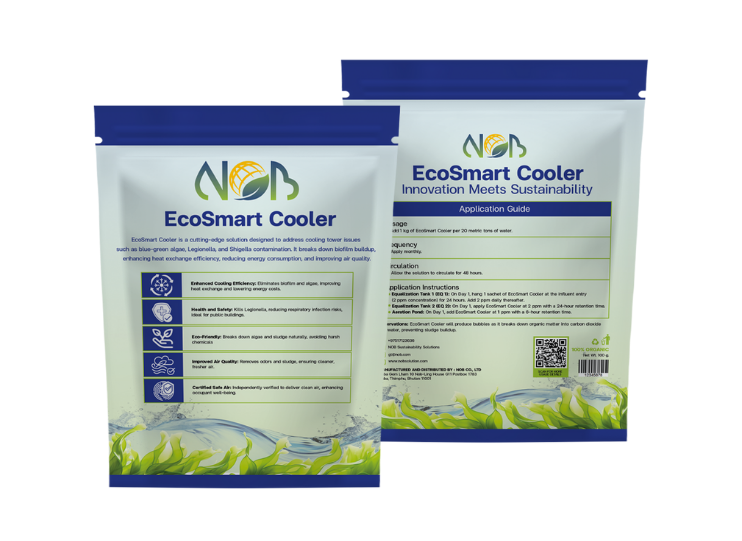EcoSmart Cooler



Product Overview
Product Name: EcoSmart Cooler
Usage: EcoSmart Cooler is a revolutionary cooling tower system solution that tackles persistent issues like blue-green algae, Legionella, and Shigella contamination, fostering a healthier environment. By digesting bio-film buildup, it improves heat exchange efficiency, leading to cooler air flow and reduced energy consumption. EcoSmart Cooler eliminates unpleasant odors and offers a sustainable, cost-effective cooling solution. Building occupants can breathe easy, knowing their air is clean, fresh, and certified safe, protecting them from respiratory diseases.
Benefits and Advantages
- Improved Cooling Efficiency and Cost Savings: By eliminating blue-green algae and biofilm, EcoSmart Cooler enhances heat exchange, leading to reduced energy consumption and lower electricity costs.
- Healthier and Safer Environments: Effectively kills Legionella bacteria, ensuring safety and reducing the risk of respiratory infections, crucial for hotels, restaurants, and public buildings.
- Sustainable and Eco-Friendly Solution: Utilizes a natural process to break down algae and sludge into harmless gases and water, offering a safe, environmentally responsible alternative to harsh chemicals.
- Enhanced Air Quality: Eliminates sludge and associated odors, resulting in fresher, cleaner air throughout the premises, contributing to a more pleasant and healthy environment.
- Certified Clean Air Delivery: Independently certified to ensure the circulation of clean, fresh air, reinforcing trust and credibility while promoting occupant well-being and productivity.
Usage Guidelines
Initial Legionella Assessment:
- Collect a water sample from the cooling tower tank.
- Send the sample for laboratory analysis to determine the Legionella count.
Cooling Tower (Need new name) Application:
- Dosage: Add 1 kg of Cooling Tower (Need New Name) in a sachet bag (similar to a tea bag) for every 20 metric tons of water in the cooling tower tank.
- Frequency: Apply once a month.
Circulation:
- Allow the water containing Cooling Tower (Need new name) to circulate throughout the cooling tower system for 48 hours (2 days).
Follow-up Legionella Testing:
- After the 48-hour circulation period, collect another water sample from the cooling tower tank.
- Send the sample for laboratory analysis to assess the effectiveness of the treatment and the new Legionella count.
Dosage Guidelines: The dosage is determined by the Biochemical Oxygen Demand (BOD), Suspended Solids (SS), and retention time. This guide uses the example of food and paper mill factories with high BOD and Total Suspended Solids (TSS) between 15,000-16,000 mg/L, and Mixed Liquor Suspended Solids (MLSS) between 10,000-20,000 mg/L.
Initial Treatment:
- Day 1 Results: After applying Cooling Tower (Need new name), BOD and MLSS are expected to decrease by 70-80%, with MLSS reducing to 3,000-4,000 mg/L on the first day.
- Retention Time Requirement: A minimum of 24 hours is crucial on the first day to allow the enzymes to work effectively.
Application Procedure:
- Equalization Tank 1 (EQ 1):
- Day 1: Add Cooling Tower (Need new name) at a concentration of 4 ppm (4 kg per 1,000 cubic meters of wastewater). Place the Cooling Tower (Need new name) in a sachet bag and hang it at the influent entry before the pond. Ensure a retention time of 24 hours.
- Subsequent Days: Add Cooling Tower (Need new name) at 2 ppm daily.
- Equalization Tank 2 (EQ 2):
- Day 1: Cooling Tower (Need new name) at a concentration of 2 ppm with a retention time of 24 hours.
- Aeration Pond:
- Day 1: Add Cooling Tower (Need new name) at a concentration of 1 ppm with a retention time of 6 hours.
Observations: Applying Cooling Tower (Need new name) will lead to visible changes, including the formation of bubbles in the pond as Cooling Tower (Need new name) breaks down organic matter into carbon dioxide and water. This is in contrast to other methods that may increase sludge and solid waste accumulation.
Recommendations:
- It is strongly advised to apply Cooling Tower (Need new name) during the initial stages, such as cleaning and rinsing processes, to maximize retention time and treatment efficiency.
- Implementing Cooling Tower (Need new name) upstream as a preventive measure is preferable over solely end-of-pipe treatment in the ponds. This approach enhances the outcomes and efficiency of the entire wastewater treatment process.

